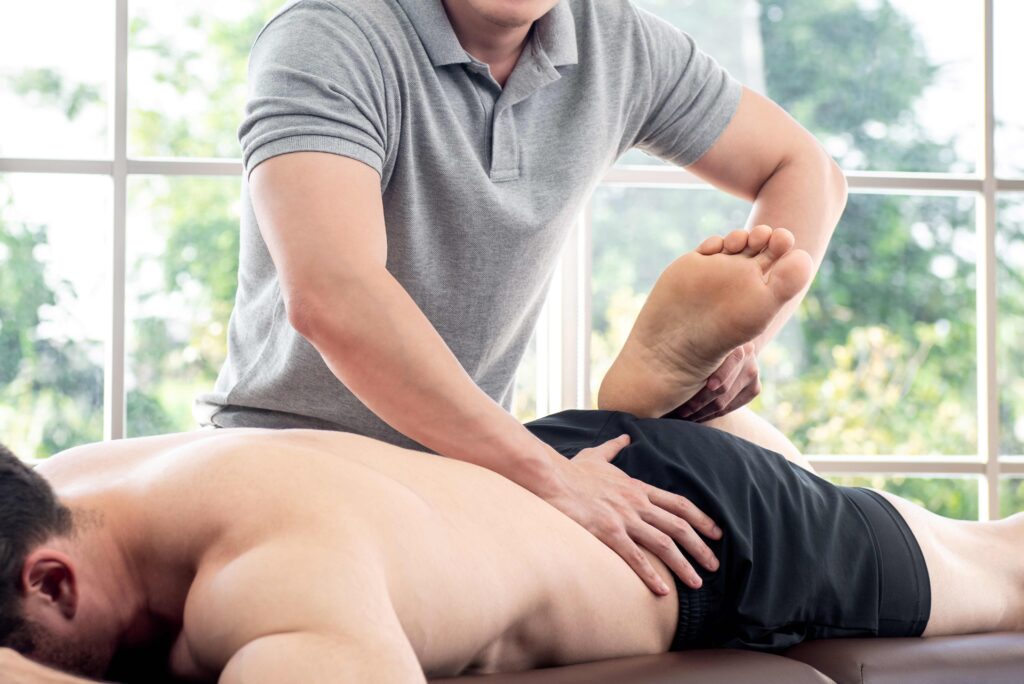Understanding Deep Tissue and Sports Massage
If you’re getting a massage after a workout, does it have to be a deep issue massage or a sports massage? Aren’t all massages the same? The truth is, massages are not all the same! After an intense exercise session, a sports massage is generally more appropriate than, say, a deep tissue massage. In this article, we’ll explore the differences between deep tissue and sports massage, helping you understand which is best for your needs.
Deep Tissue Massage: Benefits
Deep tissue massage is known for its therapeutic effects on musculoskeletal issues. It offers targeted relief from chronic pain, muscle tension, and discomfort. This massage technique penetrates the deeper layers of muscle and connective tissue. It’s highly effective for those seeking long-term solutions for pain and injury recovery. When comparing deep tissue and sports massage, deep tissue focuses on breaking down adhesions and addressing chronic conditions. Sports massage, on the other hand, is more dynamic and geared toward performance and recovery.
Relief from Chronic Pain and Muscle Rehabilitation
Treatment of Chronic Pain
Deep tissue massage is highly effective for managing chronic pain conditions. It helps with issues like lower back pain, neck and shoulder tension, sciatica, and osteoarthritis. The slow, deep strokes and sustained pressure work to break down adhesions and scar tissue, which often form after injuries or overuse. This process promotes better blood flow, increases oxygen delivery to affected areas, and reduces pain. These benefits make deep tissue massage a valuable tool for long-term pain management. When comparing deep tissue vs sports massage, deep tissue is generally the better choice for chronic pain, while sports massage is more suited for acute, sports-related discomfort.
Muscle Rehabilitation
Deep tissue massage is beneficial for individuals recovering from sports injuries, surgery, or trauma, as it helps accelerate muscle rehabilitation. By focusing on deeper muscle fibers and connective tissues, this technique facilitates the realignment of muscle fibers and the restoration of normal movement patterns. Additionally, deep tissue massage enhances lymphatic drainage. As a consequence, it reduces inflammation, encourages the removal of metabolic waste products from injured tissues, speeds up the healing process, and improves mobility.
Improved Posture and Range of Motion
Posture Correction
In today’s world, prolonged sitting, poor ergonomics, and sedentary lifestyles often lead to muscular imbalances, tightness, and poor posture. Deep tissue massage targets areas where tension and imbalances accumulate. It helps release knots and lengthen tight muscles, specially in the neck, shoulders, and lower back. This allows the body to realign itself more naturally, improving posture and reducing the strain on supporting structures.
Increased Flexibility and Range of Motion
Limited range of motion and muscle stiffness can significantly impact your daily activities and physical performance. By deeply relaxing and stretching muscle fibers, deep tissue massage improves flexibility and allows for smoother joint movement. This benefit is particularly valuable for athletes or individuals involved in physically demanding jobs, as enhanced range of motion can improve performance and prevent injury.
Stress Reduction and Mental Clarity
While primarily known for its physical benefits, deep tissue massage also plays an important role in reducing stress and promoting mental well-being. Slow, deliberate movements and deep pressure not only relax the body but also help stimulate the parasympathetic nervous system, which is responsible for triggering the body’s relaxation response. This helps reduce cortisol levels, leading to lower stress, improved mood, and enhanced mental clarity.
Enhanced Circulation and Toxin Elimination
Deep tissue massage stimulates blood flow to targeted areas, promoting better circulation. Enhanced circulation allows for more efficient delivery of nutrients and oxygen to muscles, which aids in recovery and muscle function. Furthermore, deep tissue massage helps flush out toxins and metabolic waste from the muscles, reducing inflammation and swelling. This detoxifying effect can result in faster recovery from exercise and injury, making it a favored therapy among athletes and fitness enthusiasts.
Sports Massage & Athletic Performance
Sports massage therapy is designed to meet the specific needs of athletes and individuals involved in intense physical activities. While it shares some techniques with deep tissue massage, sports massage takes a more targeted and dynamic approach. It focuses on the muscle groups and body areas most impacted by athletic performance and rigorous exercise. Sports massage is both therapeutic and preventative, helping to enhance recovery and improve overall athletic output. When comparing deep tissue vs sports massage, sports massage is ideal for immediate pre- and post-event care, whereas deep tissue is better suited for long-term structural relief.
1. Targeted Approach and Muscle Groups
Sports massage is tailored to meet the specific needs of athletes. It focuses on muscle groups that experience the most strain from physical activity. Unlike traditional relaxation massages, sports massage targets areas prone to stress. This helps prevent injuries and promotes recovery. Below are two keyways sports massage targets muscle groups for optimal results.
Focused Muscle Groups
Unlike general relaxation massages, sports massage focuses on the muscles and areas that experience the most stress from sports activities. For a runner, this could be the calves and hamstrings. For a swimmer, it might be the shoulders and upper back. This targeted treatment is crucial for addressing imbalances and tension caused by repetitive movements and intense physical effort. By concentrating on these areas, sports massage helps alleviate muscle tightness, release adhesions, and restore functional mobility.
Injury Prevention and Rehabilitation
One major benefit of sports massage is injury prevention. It keeps muscles flexible, addresses imbalances, and improves joint mobility. This reduces the risk of common sports-related injuries like strains, sprains, and overuse injuries. For athletes recovering from injury, sports massage helps with rehabilitation. It promotes blood flow to damaged tissues, reduces inflammation, and speeds up healing. Whether recovering from a hamstring strain or aiming to prevent future injuries, sports massage is a vital tool for maintaining peak physical condition.
2. Event-Specific Techniques and Performance Enhancement
Sports massage is not a one-size-fits-all approach—it’s tailored to the unique demands of each athlete and the specific physical activities they engage in. Below are keyways in which sports massage supports athletes in achieving their best results.
Tailored Techniques for Sports-Specific Needs
Sports massage therapists are well-versed in using techniques that are customized for specific sports or physical activities. For instance, a cyclist might require focused attention on the quads and lower back, while a tennis player may need work on the shoulders and forearms. These specialized techniques help address the unique muscular demands of different sports, ensuring that treatment is both relevant and effective. By tailoring the massage to the athlete’s activity, sports massage enhances performance by optimizing the functionality of key muscle groups.
Pre-Event and Post-Event Massage
Sports massage plays a pivotal role in both the preparation for and recovery from athletic events. Pre-event massage warms up the muscles, increases blood circulation, and improves flexibility, setting the athlete up for optimal performance. By stimulating the muscles and nervous system, pre-event massage helps reduce muscle stiffness and primes the body for action.
After an event, post-event massage focuses on reducing muscle soreness, alleviating fatigue, and preventing delayed onset muscle soreness (DOMS). Post-event treatments encourage the removal of metabolic waste, such as lactic acid. Thpromote faster recovery by decreasing muscle tension and inflammation. Pre- and post-event care through sports massage is essential for helping athletes maintain peak condition throughout a competition season
3. Enhanced Athletic Performance
Regular sports massage can significantly boost athletic performance. It improves flexibility, increases range of motion, and reduces muscle tightness. Athletes who include sports massage in their training recover faster. This enables them to train more effectively and perform at a higher level. Additionally, sports massage helps identify and address muscular issues before they become serious. This prevents injuries that could sideline athletes for long periods. The cumulative effects of sports massage contribute to sustained athletic development, allowing athletes to push their limits while maintaining physical health.
The Role of Sports Massage in Long-Term Athletic Success
Sports massage is not just about short-term recovery. It is a key component of long-term athletic success. Athletes who prioritize regular sports massage benefit from improved muscle function, greater resilience to injury, and enhanced performance. By incorporating this specialized massage into their routine, athletes can manage the physical demands of their sport. This ensures their bodies stay strong, flexible, and injury-free throughout their careers.
In conclusion, sports massage goes beyond simple relaxation. It offers athletes a targeted and effective way to improve performance, prevent injuries, and speed up recovery. Whether you’re a seasoned professional or a recreational athlete, sports massage provides the support needed to keep your body in optimal shape, helping you reach your full athletic potential.
Deep Tissue Massage: Benefits
Deep tissue massage is known for its therapeutic effects on musculoskeletal issues. It offers targeted relief from chronic pain, muscle tension, and discomfort. This massage technique penetrates the deeper layers of muscle and connective tissue. It’s highly effective for those seeking long-term solutions for pain and injury recovery. When comparing deep tissue vs sports massage, deep tissue focuses on breaking down adhesions and addressing chronic conditions. Sports massage, on the other hand, is more dynamic and geared toward performance and recovery.
Relief from Chronic Pain and Muscle Rehabilitation
Treatment of Chronic Pain
Deep tissue massage is highly effective for managing chronic pain conditions. It helps with issues like lower back pain, neck and shoulder tension, sciatica, and osteoarthritis. The slow, deep strokes and sustained pressure work to break down adhesions and scar tissue, which often form after injuries or overuse. This process promotes better blood flow, increases oxygen delivery to affected areas, and reduces pain. These benefits make deep tissue massage a valuable tool for long-term pain management. When comparing deep tissue vs sports massage, deep tissue is generally the better choice for chronic pain, while sports massage is more suited for acute, sports-related discomfort.
Muscle Rehabilitation
Deep tissue massage is beneficial for individuals recovering from sports injuries, surgery, or trauma, as it helps accelerate muscle rehabilitation. By focusing on deeper muscle fibers and connective tissues, this technique facilitates the realignment of muscle fibers and the restoration of normal movement patterns. Additionally, deep tissue massage enhances lymphatic drainage. As a consequence, it reduces inflammation, encourages the removal of metabolic waste products from injured tissues, speeds up the healing process, and improves mobility.
Improved Posture and Range of Motion
Posture Correction
In today’s world, prolonged sitting, poor ergonomics, and sedentary lifestyles often lead to muscular imbalances, tightness, and poor posture. Deep tissue massage targets areas where tension and imbalances accumulate. It helps release knots and lengthen tight muscles, specially in the neck, shoulders, and lower back. This allows the body to realign itself more naturally, improving posture and reducing the strain on supporting structures.
Increased Flexibility and Range of Motion
Limited range of motion and muscle stiffness can significantly impact your daily activities and physical performance. By deeply relaxing and stretching muscle fibers, deep tissue massage improves flexibility and allows for smoother joint movement. This benefit is particularly valuable for athletes or individuals involved in physically demanding jobs, as enhanced range of motion can improve performance and prevent injury.
Stress Reduction and Mental Clarity
While primarily known for its physical benefits, deep tissue massage also plays an important role in reducing stress and promoting mental well-being. Slow, deliberate movements and deep pressure not only relax the body but also help stimulate the parasympathetic nervous system, which is responsible for triggering the body’s relaxation response. This helps reduce cortisol levels, leading to lower stress, improved mood, and enhanced mental clarity.
Enhanced Circulation and Toxin Elimination
Deep tissue massage stimulates blood flow to targeted areas, promoting better circulation. Enhanced circulation allows for more efficient delivery of nutrients and oxygen to muscles, which aids in recovery and muscle function. Furthermore, deep tissue massage helps flush out toxins and metabolic waste from the muscles, reducing inflammation and swelling. This detoxifying effect can result in faster recovery from exercise and injury, making it a favored therapy among athletes and fitness enthusiasts.
Sports Massage & Athletic Performance
Sports massage therapy is designed to meet the specific needs of athletes and individuals involved in intense physical activities. While it shares some techniques with deep tissue massage, sports massage takes a more targeted and dynamic approach. It focuses on the muscle groups and body areas most impacted by athletic performance and rigorous exercise. It is both therapeutic and preventative, helping to enhance recovery and improve overall athletic output. When comparing deep tissue and sports massage, sports massage is ideal for immediate pre- and post-event care, whereas deep tissue is better suited for long-term structural relief.
1. Targeted Approach and Muscle Groups
Sports massage is tailored to meet the specific needs of athletes. It focuses on muscle groups that experience the most strain from physical activity. Unlike traditional relaxation massages, it targets areas prone to stress. This helps prevent injuries and promotes recovery. Below are two keyways sports massage targets muscle groups for optimal results.
Focused Muscle Groups
Unlike general relaxation massages, sports massage focuses on the muscles and areas that experience the most stress from sports activities. For a runner, this could be the calves and hamstrings. For a swimmer, it might be the shoulders and upper back. This targeted treatment is crucial for addressing imbalances and tension caused by repetitive movements and intense physical effort. By concentrating on these areas, sports massage helps alleviate muscle tightness, release adhesions, and restore functional mobility.
Injury Prevention and Rehabilitation
One major benefit of sports massage is injury prevention. It keeps muscles flexible, addresses imbalances, and improves joint mobility. This reduces the risk of common sports-related injuries like strains, sprains, and overuse injuries. For athletes recovering from injury, sports massage helps with rehabilitation. It promotes blood flow to damaged tissues, reduces inflammation, and speeds up healing. Whether recovering from a hamstring strain or aiming to prevent future injuries, sports massage is a vital tool for maintaining peak physical condition.
2. Event-Specific Techniques and Performance Enhancement
Sports massage is not a one-size-fits-all approach—it’s tailored to the unique demands of each athlete and the specific physical activities they engage in. Below are keyways in which sports massage supports athletes in achieving their best results.
Tailored Techniques for Sports-Specific Needs
Sports massage therapists are well-versed in using techniques that are customized for specific sports or physical activities. For instance, a cyclist might require focused attention on the quads and lower back, while a tennis player may need work on the shoulders and forearms. These specialized techniques help address the unique muscular demands of different sports, ensuring that treatment is both relevant and effective. By tailoring the massage to the athlete’s activity, sports massage enhances performance by optimizing the functionality of key muscle groups.
Pre-Event and Post-Event Massage
Sports massage plays a pivotal role in both the preparation for and recovery from athletic events. Pre-event massage warms up the muscles, increases blood circulation, and improves flexibility, setting the athlete up for optimal performance. By stimulating the muscles and nervous system, pre-event massage helps reduce muscle stiffness and primes the body for action.
After an event, post-event massage focuses on reducing muscle soreness, alleviating fatigue, and preventing delayed onset muscle soreness (DOMS). Post-event treatments encourage the removal of metabolic waste, such as lactic acid. Thpromote faster recovery by decreasing muscle tension and inflammation. Pre- and post-event care through sports massage is essential for helping athletes maintain peak condition throughout a competition season
3. Enhanced Athletic Performance
Regular sports massage can significantly boost athletic performance. It improves flexibility, increases range of motion, and reduces muscle tightness. Athletes who include sports massage in their training recover faster. This enables them to train more effectively and perform at a higher level. Additionally, sports massage helps identify and address muscular issues before they become serious. This prevents injuries that could sideline athletes for long periods. The cumulative effects of sports massage contribute to sustained athletic development, allowing athletes to push their limits while maintaining physical health.
The Role of Sports Massage in Long-Term Athletic Success
Sports massage is not just about short-term recovery. It is a key component of long-term athletic success. Athletes who prioritize regular sports massage benefit from improved muscle function, greater resilience to injury, and enhanced performance. By incorporating this specialized massage into their routine, athletes can manage the physical demands of their sport. This ensures their bodies stay strong, flexible, and injury-free throughout their careers.
In conclusion, sports massage goes beyond simple relaxation. It offers athletes a targeted and effective way to improve performance, prevent injuries, and speed up recovery. Whether you’re a seasoned professional or a recreational athlete, sports massage provides the support needed to keep your body in optimal shape, helping you reach your full athletic potential.
Deep Tissue or Sports Massage: Which One Then?
Whether you’re seeking relief from chronic pain, aiming to enhance athletic performance, or simply wanting to recover more effectively from intense physical activity, both deep tissue and sports massage offer unique benefits. Deep tissue massage provides long-term pain relief and muscle rehabilitation, making it ideal for addressing chronic issues and structural alignment. Sports massage, on the other hand, is designed for active individuals, offering targeted care that supports performance, injury prevention, and recovery.
Understanding the specific benefits of each type can help you make an informed choice, ensuring you get the right support for your body’s needs.
An Individualized Approach To Wellness
At Pledge To Fitness® in Houston, we offer a comprehensive suite of wellness services, including personal training, massage therapy, and nutrition coaching, all designed to rejuvenate your body, mind, and spirit. From Swedish and deep tissue massages to sports massage and passive stretching, our skilled therapists ensure you feel relaxed, restored, and revitalized. We customize each program to fit your needs, budget, and schedule, providing flexible session options with no obligation for extra purchases. Our focus is on delivering real results and empowering you with sustainable wellness habits.
Ready to revitalize your wellness journey? Book your first session with Pledge To Fitness® today!



